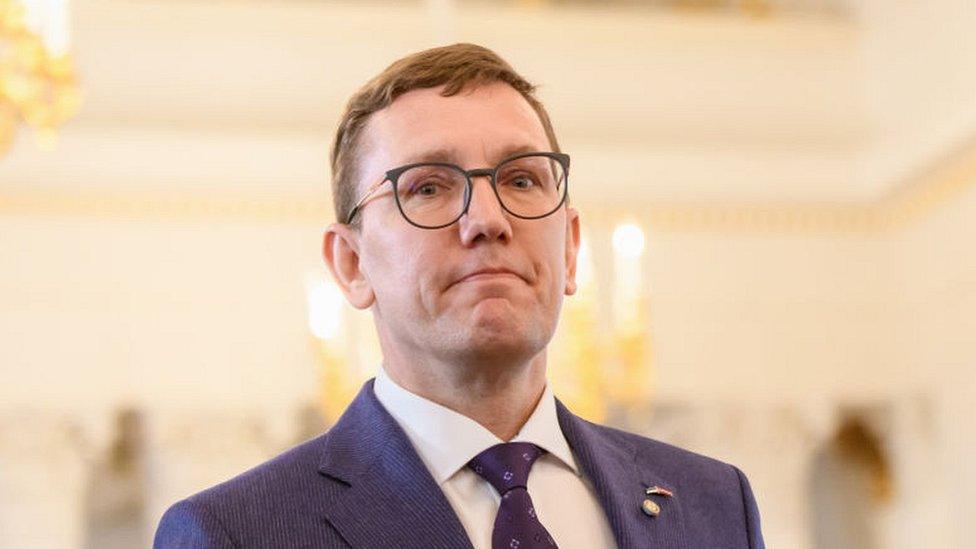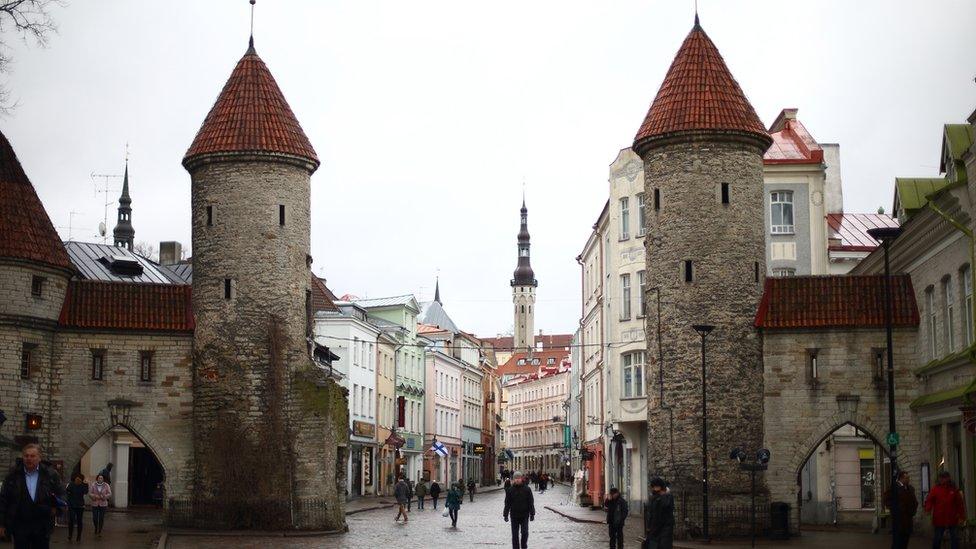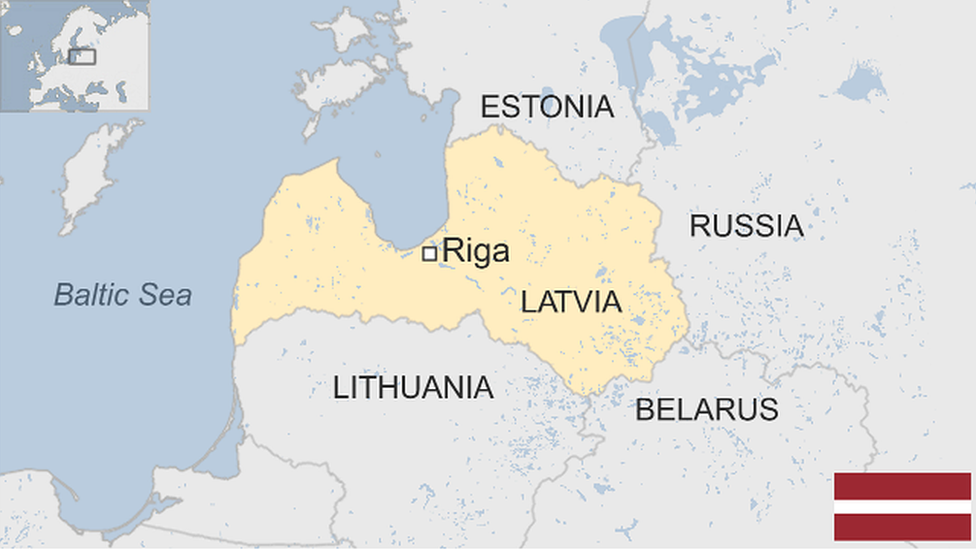Estonia country profile
- Published
This page is no longer being updated. It was last updated on 23 July 2024

Estonia is the most northerly of the three Baltic states, and has linguistic ties with Finland.
Since regaining its independence with the collapse of the Soviet Union in 1991, Estonia has become one of the most economically successful of the EU's eastern European members. Estonia joined both the EU and Nato in 2004.
Ruled at various times during the middle ages by Denmark, the German knights of the Livonian Order, and Sweden, Estonia ended up part of the Russian Empire in the 18th Century.
It experienced its first period of independence in 1918, following the end of World War One and the collapse of the Russian Empire.
Read more country profiles, external - Profiles by BBC Monitoring, external
REPUBLIC OF ESTONIA: FACTS
Capital: Tallinn
Area: 45,339 sq km
Population: 1.3 million
Language: Estonian
Life expectancy: 74 years (men) 82 years (women)
LEADERS
President: Alar Karis

Alar Karis was elected by Parliament on 31 August 2021, replacing Kersti Kaljulaid.
Estonia is one of the few parliamentary republics in which the president is a ceremonial figurehead without even nominal executive powers. The president is not directly elected by voters, but by parliament.
Prime minister: Kristen Michal

Estonia's parliament voted in Kristen Michal as prime minister in July 2024 after his predecessor Kaja Kallas - Estonia's first woman prime minister -resigned to take up the post of European Union's chief diplomat.
Kallas had already named Michal as a possible candidate to succeed her as prime minister and chairman of the party - both come from the country's centre-right Reform party.
Michal will lead the same majority coalition as his predecessor, which is composed of Reform, the liberal party Estonia 200 and the centre-left Social Democrats.
The government has said it will put up income tax and purchase taxes in order to improve the country's ailing state finances.
Michal has also pledged to continue investing strongly into defence and security. The continuance of the coalition government means that Tallinn remains one of Europe's most staunchly pro-Kyiv governments.
MEDIA

Held every five years, Estonia's Nationwide Song and Dance Festival attracts thousands of performers and spectators
Television is Estonia's most popular medium, while print media are losing ground to online outlets.
The broadcasting industry has attracted foreign media groups; the main privately-owned TVs are run by Swedish and Norwegian concerns.
Eesti Televisioon (ETV) and Eesti Raadio (ER) are public broadcasters. Take-up of cable and digital terrestrial TV is extensive; the offering includes stations in Finnish, Swedish, Russian and Latvian.
Read full media profile
TIMELINE

The city gates in Talinn
Some key dates in Estonia's history:
1918 - Independence proclaimed.
1920 - Peace treaty with Russia signed.
1934 - Prime Minister Konstantin Pats leads bloodless coup and establishes authoritarian rule.
1939 - World War Two: The Soviet Union compels Estonia to accept Soviet military bases.
1940 - Soviet troops march in. Estonia is forcibly incorporated into Soviet Union.
1941 - German troops invade Estonia as part of their invasion of the USSR.
1944 - Soviet forces push back German troops across eastern Europe and Estonia reannexed by the Soviet Union.
1944-50 - Tens of thousands of Estonians deported to Siberia and Central Asia. USSR begins "Russification" with hundreds of thousands of ethnic Russians and other "Soviet people" settling in Estonia.
1988 - Popular Front campaigns for democracy. "Singing revolution" brings a third of the population together in a bid for national unity and self-determination.
1991 - Communist rule collapses. Soviet government recognizes the independence of the Baltic republics.
1994 - Russian troops leave. Estonia joins Partnership for Peace, allowing limited military cooperation with Nato.
852 people die when the MS Estonia sinks en route from Tallinn to Stockholm, in one of the 20th Century's worst maritime disasters.
2003 - Estonians vote overwhelmingly to join the European Union.
2004 - Estonia admitted to Nato and is one of 10 new states to join the EU.
2005 - Estonia and Russia sign treaty delineating border. Parliament ratifies border treaty with Russia but defies warnings from Moscow by introducing amendment referring to Soviet occupation. Russia reacts by withdrawing from treaty.
2007 - Parliament passes a law prohibiting the display of monuments glorifying Soviet rule, paving the way for the relocation of a controversial Red Army war memorial in Tallinn.
Estonia becomes the first country to allow internet voting for parliamentary elections.
Authorities relocate the Red Army war memorial in Tallinn. One person is killed and more than 40 injured as protesters, mostly ethnic Russians, try to halt the removal.
2011 - Estonia adopts the euro.
2012 - Estonia and Russia re-start talks on a border treaty.
2014 - Estonia and Russia sign a new treaty ending their border dispute.
Amid tension with the European Union and Nato over Russian intervention in Ukraine, Estonia accuses Moscow of abducting border guard Eston Kohver. Russia says he was on the Russian side of the border and accuses him of spying.
2015 - Nato reinforces its presence in the Baltic states.
Russia returns detained border guard Eston Kohver in return for Aleksei Dressen, imprisoned in Estonia in 2012 on charges of spying for Moscow.
2017 - British troops arrive in Estonia as part of a major Nato mission in the Baltic states to deter what the alliance regards as Russian aggression.
2021 - Kaja Kallas became Estonia's first woman prime minister.
2022 - Russia invades Ukraine. Estonia is prominent among those giving Ukraine military equipment and political support.

Estonia's capital Tallinn is one of the best-preserved medieval cities in Europe
- Published29 March 2023

- Published13 February 2024

- Published25 March 2024

- Published22 August 2023

- Published25 November 2024

- Published27 January

- Published22 August 2023
